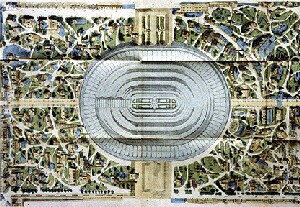|
1 |
 Copyright: Ebeling, Anhang |
|
1 |
 Copyright: Ebeling, Anhang |
In order to present to the world the brilliance of the emperor´s Second Empire, the organisers wanted to place special emphasis on France´s technological and economic progress. The setting of the Exposition universelle was the townscape of Paris, radically renewed by Baron Haussmann. But it wasn´t only in terms of size and numbers of visitors that this world exposition should overshadow all past projects. The concept of the exhibition´s commissioner, Frédéric Le Play, featured innovative approaches which decisively influenced later world expositions. For the first time, using a comprehensive classification system, an attempt was made to classify all areas of human endeavour into only ten groups, which in turn were divided into several classes. The differentiations made were: 1. Objets d´art, 2. Material and application in the liberal arts, 3. Furniture and domestic appliances, 4. Clothing, materials and other objects worn by people (e.g. jewellery and weapons), 5. Industrial products and machines for producing raw materials, 6. Instruments and processes in applied arts, 7. Foodstuffs, 8. Agricultural products, 9. Horticultural products and finally 10. Objects for the improvement of the physical and moral situation of nations. This tenth group not only introduced products, but also took into consideration human activities and their conditions within society. It was intended that the exhibition visitor should gain an insight into manufacturing processes through presentations of both craftsmanship and machine production. Apart from this, one wanted to win over the public with services such as those of hatmakers and shoemakers, who performed repair work or offered their newly produced goods for sale. But teaching aids were also shown in Group 10 and efforts to find better living concepts explained. That one placed special emphasis on this moral consideration at a time of increasing social conflicts can also be deduced from Napoleon´s personal contribution to the exhibition. The emperor presented the design of a worker´s house which, as was to be expected, was awarded a Grand Prix by the jury. In addition, the development of civilisation from the French point of view was presented in an exhibition on the history of labour, for which material deriving from the Stone Age up to the 19th century was made available.
Le Play developed a spatial concept for this status assessment, a concept which gathered all themes and countries under one roof, but which led away from a mere competition between participating nations. Visitors were able to make their way in the palace to either a country or a product category, according to which direction they moved in. In order to emphasise the exhibits and the equality of their organisation within a harmonising system of order, a rational spatial solution had to be developed. A giant oval ground plan was the obvious choice, where concentric zones accommodated products of the same group from all nations, and where radial sections were allocated to each nation. However, France occupied almost half of the palace and in the final analysis, the remaining areas were also allocated in accordance with the prestige of the respective nations. In addition, Le Play´s concept was oriented against the tradition of customary palace architecture, a tradition in which historical styles were adapted and a hierarchical space arrangement was typical. Even though the world model set up by the French in its ring form was used to demonstrate their own cultural position of superiority, the idea of later theme exhibitions had now been realised. And in addition, for the first time, the exhibiting nations were given the opportunity of erecting pavilions in the exhibition park surrounding the palace which were designed by themselves and reflected their own interests.
| Year: 1867 | City: Paris | Country: France |
| Duration: 1st April - 3rd November 1867 | ||